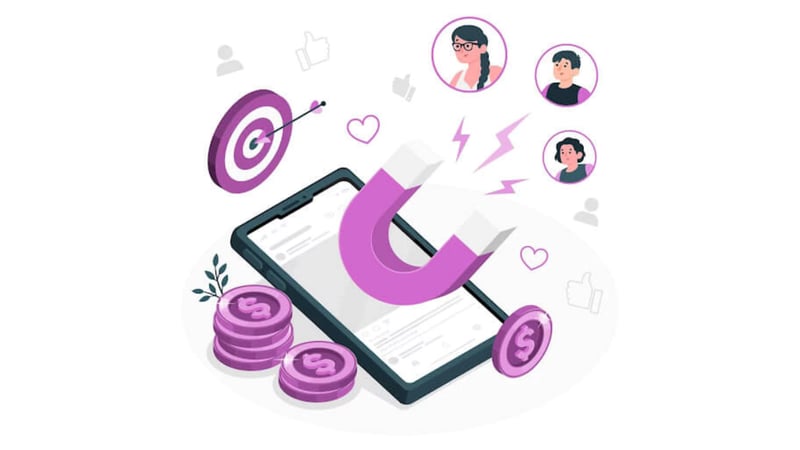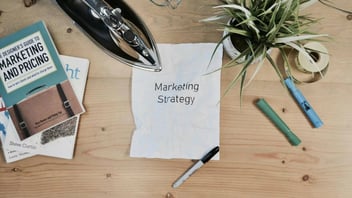许多 SaaS 公司认为,成功的营销活动需要复杂的策略和高额的预算。然而,事实是,通过战略规划和对客户核心需求的关注,可以实现强大的转化率。
本指南将为您提供五种有效的策略,无论预算多少,都能达到预期效果。

想象一下你的工作日。
在身份和访问工具(如 Okta)的帮助下,您登录到安全网络,准备开始工作。您可能会查看 Microsoft Teams 账户,回复已经在线的同事的消息。然后,你会前往你的项目管理程序,也许是 Asana,委派一些任务,并挑选一些自己的任务。为今天的第一次会议做好准备,毫无疑问,这次会议需要使用 Zoom 等视频工具。
短短片刻间,你已经依赖了无数的软件即服务(SaaS)提供商。在整个公司和工作日中,与 SaaS 公司的接触点还有很多。
你的营销团队可能正在使用HubSpot 准备他们的月度内容。您的会计团队正在借助 Workday 等企业管理软件向供应商付款。你的销售团队很可能正在通过 Salesforce 追踪他们的销售线索。
据估计,企业使用的应用程序中有 70% 是 SaaS。显然,SaaS 已成为 2024 年工作场所不可或缺的一部分。
如果你正试图推出 SaaS 产品,并建立与当今许多最大的 SaaS 公司相同的认可度和留存率,这里有你需要了解的关于有效的 B2B SaaS 营销的一切。
了解 SaaS 营销的复杂性
软件即服务的理念源于20 世纪 60 年代和 70 年代的分时系统,它允许多个用户同时访问一台计算机。
如今,SaaS 是一种通过互联网提供应用程序功能的做法。它使公司无需在本地构建、安装和维护软件,从而节省了团队的时间、金钱和压力。
SaaS 营销与传统营销的不同之处就体现在功能上与传统软件的反差上。
SaaS 营销与众不同,因为它向受众宣传的是无形的(而且往往是复杂的!)产品。正因为如此,SaaS 营销人员在制定营销计划时需要考虑一些独特的变量,包括
-
锁定决策者和拥护者: 虽然很多 B2B SaaS 公司确实将其产品面向工作空间内的最终用户,但在 B2B 领域,更大、更常见的玩法是刻意瞄准企业及其内部的决策者,因为他们不太可能真正为自己使用软件。这些人或者是对其部门的购买决策有影响力的倡导者。与这些人建立关系还有助于留住客户,这可能是比收购更好的目标,尤其是对于价格高、销售周期长的产品--下一步将讨论这些话题。所有这一切都意味着,营销材料必须足够强大,以说服高管和其他高层管理者相信你的产品能够实现他们的公司目标。
-
冗长的客户旅程: 由于产品是无形的,而且通常相当复杂(价格昂贵),SaaS 产品可能需要更多的时间、更多的演示和更多的教育材料,才能帮助潜在客户看到产品的价值。这意味着市场营销和销售团队需要通力合作,加强宣传活动,而整个进入市场(GTM)部门也应做好准备,度过漫长而曲折的客户旅程。
-
更高更复杂的定价: SaaS 平台非常适合基于订阅的分层定价,这通常需要在不同的价位提供不同的功能。作为拥有众多功能和商业受众的强大平台,其定价通常也偏高。这些因素意味着营销人员必须努力明确划分每种定价套餐的含义,并确保针对正确的受众发送信息,以免吓跑预算较低的购物者。
如何开展能产生转化的 SaaS 营销活动
现在,让我们来讨论创建一个有效的 SaaS 营销活动,帮助公司在新的受众、更长的旅程和更高的定价中游刃有余,从而在不断增长的 SaaS 领域脱颖而出。
1.了解你的买家角色
营销漏斗的最顶端当然是认知阶段。在过去的几十年里,B2B 营销领域在认知阶段最大的策略之一就是打冷电话。但是,在你拿起电话之前,你可能要打消这个念头。
你可能听人说过,年轻一代讨厌打电话。这个说法是对的,但对冷电话来说尤其准确。研究表明,千禧一代认为打电话既耗时又令人焦虑。千禧一代在 B2B 公司中占据73% 的重要采购决策职位,因此,您的 B2B 营销必须以这一群体为目标。
虽然这并不是说 B2B 市场上已经没有冷电话的用武之地,但这表明,随着年轻一代逐渐成为购买力的目标,一些公司可能需要重新调整他们的营销工作。

2.首先将自己打造成思想领袖
为了吸引千禧一代和更年轻的关键决策者,投入更多的时间进行 "内向型 "营销可能比 "外向型 "营销更有成效。当你投入更多的内向营销策略,如内容营销和搜索引擎优化(SEO)时,你会发现在关键的认知阶段,会有更多的人 "偶然 "发现你的网站。
现在,有人知道了你的公司,并且正在研究如何解决问题,而你可能有答案。将博文作为第一个接触点,就等于为潜在客户提供了价值。下一步就是让他们从这个接触点开始考虑购买贵公司的产品。
3.找到你的 "在"
在入站营销将目光吸引到你的公司之后,你需要将潜在买家进一步推向漏斗。作为 SaaS 营销人员,你应该知道 "免费 "这个词并不可怕。你的大部分收入可能来自订阅,但你是如何做到这一点的呢?对于许多 SaaS 产品来说,"进入 "是通过免费试用或分层。
例如,考虑一下 Slack 的成功。Slack 的使用是免费的,但有一些限制,但你可以升级到付费计划。Slack 拥有30% 的转换率,这在 SaaS 行业中是惊人的高。大多数 "正常 "的转化率都在 1%左右。Slack 的成功表明,在 SaaS 领域,营销免费计划并不可怕。
 虽然免费模式可能对某些人有效,但其他公司发现,最好对用户试用功能的时间加以限制。免费试用被认为是 SaaS 营销的最佳形式之一,在你的 "渠道底层 "营销工作中使用尤其有益,因为在这个阶段,你的潜在用户已经过了认知阶段,正在积极地参与他们的选择,为他们的问题找到正确的解决方案。
虽然免费模式可能对某些人有效,但其他公司发现,最好对用户试用功能的时间加以限制。免费试用被认为是 SaaS 营销的最佳形式之一,在你的 "渠道底层 "营销工作中使用尤其有益,因为在这个阶段,你的潜在用户已经过了认知阶段,正在积极地参与他们的选择,为他们的问题找到正确的解决方案。
4.锁定目标和重定向
一旦您获得了客户,然后呢?
虽然每家公司的销售关键绩效指标各不相同,但客户获取成本(CAC)通常是客户保留成本的五倍左右。这对市场营销来说意味着,您的团队应该花同样多的时间(如果不是更多的话)对现有客户进行再定向销售,而不是去寻找新的买家。
如果考虑到 B2B 销售周期的典型长度,您就会明白为什么与已经购买过产品的客户进行联系是有益的。在平均销售周期不断延长的今天,这一点比以往任何时候都更加重要。
根据Theory Ventures 的一项调查,在 2022 年至 2023 年期间,初创企业的平均销售周期长度增加了 24%。这一统计数字可能表明,企业正在寻求减少开支,并花更多时间研究 SaaS 产品,以确保购买正确的产品,这可能会使获得新客户变得更加困难。
关注现有客户可以帮助你驾驭潜在的困难市场,而电子邮件营销在这方面可以帮上大忙。整理并清理您的电子邮件列表,然后制定电子邮件策略,帮助您向现有客户进行追加销售。
在您推出新功能、进行品牌重塑或您认为客户可能想了解您即将发布的新闻时,都可以发送电子邮件。您还应细分您的名单,以确保充分利用您的联系。如果联系过多,您的客户可能会将您标记为垃圾邮件,从而损害你们之间的关系。
5.将客户成功与 SaaS 营销相结合
将客户成功(CS)团队视为 SaaS 营销的延伸。
客户成功团队可以在留住客户和重新定位方面发挥重要作用。让您的客户成功团队与现有客户保持联系,并展示您对客户的关心,他们可能会更有兴趣投入更多的时间、精力和金钱到你们的关系中。他们也是一个重要的反馈来源,可以帮助企业改进产品和营销。
你甚至可以请客户协助你的 SaaS 营销工作。考虑启动一个推荐计划,这可以帮助你降低获取成本,或者请你的用户对你的产品进行评论,这可以帮助你把你的名字传播出去。
口碑营销价值连城,尤其是在 SaaS 行业。麦肯锡(McKinsey)发现,口碑是高达 50%的购买决策的主要因素。增加口碑广告有助于您保持竞争力,并继续通过已有客户赢得新客户。
在基于订阅的世界中把握 SaaS 营销
SaaS 营销要求你寻找拥护者、培养关系并依靠更多的内向型策略。它还要求你放弃销售一次性产品的想法。你要销售的是一种高价值的解决方案,而你在 SaaS 营销中的最大目标就是将其传达给合适的客户,即其他公司的关键决策者。
SaaS 将继续发展,我们的营销方式也将随之改变。然而,我们决不能忘记的一点是,B2B SaaS 营销尽管有其技术根基和业务重点,但却是一项以人为本的职能。培养正确的关系,你就会获得回报。











.webp?width=352&name=Call%20centres%20still%20relevant%20(1).webp)
发表评论